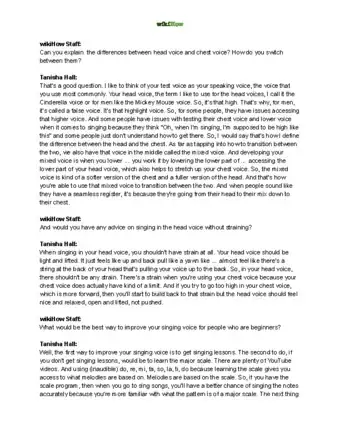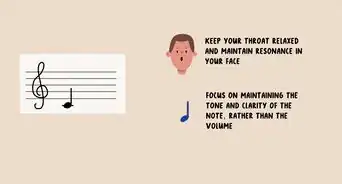This article was co-authored by Tanisha Hall. Tanisha Hall is a Vocal Coach and the Founder and Executive Director of White Hall Arts Academy, Inc. an organization based in Los Angeles, California that offers a multi-level curriculum focused on fundamental skills, technique, composition, theory, artistry, and performance at a conservatory level. Ms. Hall's current and previous students include Galimatias, Sanai Victoria, Ant Clemons, and Paloma Ford. She earned a BA in Music from the Berklee College of Music in 1998 and was a recipient of the Music Business Management Achievement Award.
wikiHow marks an article as reader-approved once it receives enough positive feedback. In this case, several readers have written to tell us that this article was helpful to them, earning it our reader-approved status.
This article has been viewed 98,665 times.
Many singers like Mariah Carey and Christine Aguilera are known for their enormous vocal ranges. A big part of singing with a wide range is learning to differentiate between your head and chest voice. Start with step 1 for some strategies to help you learn to differentiate between and sing with your head and chest voices.
Steps
-
1Learn what chest and head voice are. Here is a very loose explanation:[1]
- Chest voice: The lower register of your voice when you are speaking or singing. When you are having a conversation with a friend, you are likely using your chest voice to speak to them.
- Head voice: The higher register of your voice when you are speaking or singing. Some people speak in their head voice when they are nervous or speaking to strangers.
- There's also a kind of voice in-between those two types, called mixed voice. It is a softer version of the chest and a fuller version of the head, and it can be used as a transition between the two types.
-
2Learn what they feel like. What does it feel like to sing or speak in your head and chest voice?[2]
- Chest voice: When you speak or sing in your chest voice, it should feel like the tone is resonating in your chest. The sound should feel (and sound) like there is more power backing it up. There's strain when you're using your chest voice because it does have kind of a limit.
- Head voice: When you speak or sing in your head voice, it should feel like the tone is resonating in your head. The sound should be more light and gentle than in your chest voice. When singing in your head voice, you shouldn't have strain at all. Your head voice should be light and lifted.
Advertisement -
3To sing in your chest voice, begin speaking in your normal voice. As you speak, slowly transition the words into an "ooh". If you had been speaking in your normal voice, the singing you will hear should be in your chest voice. Practice doing this until you are confident that you know what it feels like in your face, throat, and chest.
-
4To sing in your head voice, begin a high voice, but not a squeaky voice. As you speak, do as you did in the previous step. The singing you will hear should be your head voice. Practice until you know what your head voice feels like to you.[3]
-
5Be careful. It's important to take caution when you are singing! Don't try to sing high notes in your chest voice for more power. Do what feels comfortable to you and make sure not to overuse your voice!
Community Q&A
-
QuestionMy voice goes high and low but is not cracking. Am I doing something wrong?
 Community AnswerNo. Your voice may just need time and practice. Try vocal exercises everyday. Make sure you are in control of your voice, and keep practicing.
Community AnswerNo. Your voice may just need time and practice. Try vocal exercises everyday. Make sure you are in control of your voice, and keep practicing. -
QuestionWhich is easier to sing with, head voice or chest voice?
 Tatum PowellCommunity AnswerIt depends on your vocal range. If your voice is higher-pitched, head voice is best for you. If your voice is lower-pitched, chest voice is best for you.
Tatum PowellCommunity AnswerIt depends on your vocal range. If your voice is higher-pitched, head voice is best for you. If your voice is lower-pitched, chest voice is best for you. -
QuestionHow can I sing alto songs better if my voice is naturally high and I have a habit of singing in my head voice with high notes?
 Community AnswerSing songs that you are comfortable with. If you have an existing habit, try singing different alto songs and putting your own twist on them.
Community AnswerSing songs that you are comfortable with. If you have an existing habit, try singing different alto songs and putting your own twist on them.
Warnings
- Don't strain your voice! Use the tips in part 3 and consult a vocal coach before experimenting with mixed voice and vocal fry.⧼thumbs_response⧽
Expert Interview

Thanks for reading our article! If you'd like to learn more about singing, check out our in-depth interview with Tanisha Hall.
















-Step-5-Version-2.webp)















































